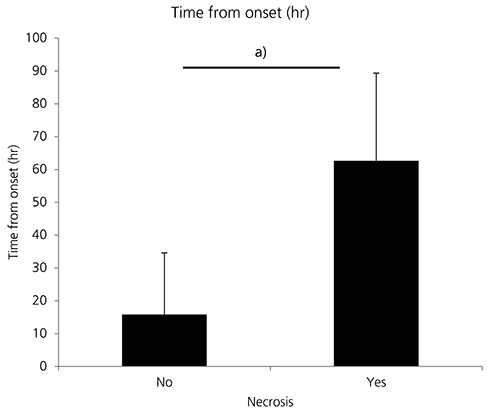Obstet Gynecol Sci.
2018 May;61(3):386-394. 10.5468/ogs.2018.61.3.386.
Combination of clinical and laboratory characteristics may serve as a potential diagnostic marker for torsion on mature cystic teratomas
- Affiliations
-
- 1Department of Obstetrics and Gynecology, Gangnam Severance Hospital, Yonsei University College of Medicine, Seoul, Korea. sihyuncho@yuhs.ac
- 2Department of Obstetrics and Gynecology, Institute of Women's Life Medical Science, Yonsei University College of Medicine, Seoul, Korea.
- KMID: 2416128
- DOI: http://doi.org/10.5468/ogs.2018.61.3.386
Abstract
OBJECTIVE
The objective of this study was to evaluate clinical and laboratory characteristics of torsion on mature cystic teratomas (MCTs). In addition, we examined whether these factors could be helpful in diagnosing MCT torsion.
METHODS
A retrospective medical record review was conducted for 384 patients who had undergone surgery and histologically verified ovarian MCTs at single university hospital between July 2006 and May 2017. Patients with or without torsion groups were compared with respect to clinical presentation, laboratory findings and surgical course. In addition, statistically significant indicators of the factors were additionally evaluated for diagnostic value.
RESULTS
White blood cell (WBC) count, neutrophil count, neutrophil to lymphocyte (N/L) ratio, and tumor size were higher in the torsion group (n=24) than in the control group (n=360; P≤0.005 for all). The age was younger in the torsion group than in the control (P=0.009). In the area under the curve (AUC) of the 5 factors obtained by univariate and multivariate logistic regression, the age was 0.657, the WBC count was 0.838, the neutrophil count was 0.806, the N/L ratio was 0.725, and the cyst size was 0.705. Receiver operating characteristic analysis indicated that the AUC for the combined use of age, WBC count, neutrophil count, N/L ratio, and tumor size was 0.898 (95% confidence interval, 0.833-0.962; P < 0.001).
CONCLUSION
The combined measurement of age, WBC count, neutrophil count, N/L ratio, and tumor size may be used as a potential diagnostic marker for the torsion on MCTs.
MeSH Terms
Figure
Reference
-
1. Ayhan A, Bukulmez O, Genc C, Karamursel BS, Ayhan A. Mature cystic teratomas of the ovary: case series from one institution over 34 years. Eur J Obstet Gynecol Reprod Biol. 2000; 88:153–157.
Article2. Comerci JT Jr, Licciardi F, Bergh PA, Gregori C, Breen JL. Mature cystic teratoma: a clinicopathologic evaluation of 517 cases and review of the literature. Obstet Gynecol. 1994; 84:22–28.3. Pradhan P, Thapa M. Dermoid Cyst and its bizarre presentation. JNMA J Nepal Med Assoc. 2014; 52:837–844.
Article4. Kim SH, Kim YJ, Park BK, Cho JY, Kim BH, Byun JY. Collision tumors of the ovary associated with teratoma: clues to the correct preoperative diagnosis. J Comput Assist Tomogr. 1999; 23:929–933.
Article5. Hurwitz JL, Fenton A, McCluggage WG, McKenna S. Squamous cell carcinoma arising in a dermoid cyst of the ovary: a case series. BJOG. 2007; 114:1283–1287.
Article6. von-Walter AR, Nelken RS. Benign cystic ovarian teratoma with a fistula into the small and large bowel. Obstet Gynecol. 2012; 119:434–436.
Article7. Ercan Ö, Köstü B, Bakacak M, Coşkun B, Tohma A, Mavigök E. Neutrophil to Lymphocyte ratio in the diagnosis of adnexal torsion. Int J Clin Exp Med. 2015; 8:16095–16100.8. Graif M, Itzchak Y. Sonographic evaluation of ovarian torsion in childhood and adolescence. AJR Am J Roentgenol. 1988; 150:647–649.
Article9. Nichols DH, Julian PJ. Torsion of the adnexa. Clin Obstet Gynecol. 1985; 28:375–380.
Article10. Wang YQ, Xia WT, Wang F, Zhuang XX, Zheng FY, Lin F. Use of cancer antigen 125, cancer antigen 19-9, and the neutrophil-to-lymphocyte ratio to diagnose mature cystic teratoma with torsion. Int J Gynaecol Obstet. 2017; 137:332–337.
Article11. Kim MJ, Kim NY, Lee DY, Yoon BK, Choi D. Clinical characteristics of ovarian teratoma: age-focused retrospective analysis of 580 cases. Am J Obstet Gynecol. 2011; 205:32.e1–32.e4.
Article12. Dede M, Gungor S, Yenen MC, Alanbay I, Duru NK, Hasimi A. CA19-9 may have clinical significance in mature cystic teratomas of the ovary. Int J Gynecol Cancer. 2006; 16:189–193.
Article13. Cho HY, Kim K, Jeon YT, Kim YB, No JH. CA19-9 elevation in ovarian mature cystic teratoma: discrimination from ovarian cancer - CA19-9 level in teratoma. Med Sci Monit. 2013; 19:230–235.
Article14. Artunc Ulkumen B, Goker A, Pala HG, Ordu S. Abnormal elevated CA 19-9 in the dermoid cyst: a sign of the ovarian torsion? Case Rep Obstet Gynecol. 2013; 2013:860505.
Article15. Suh DS, Moon SH, Kim SC, Joo JK, Park WY, Kim KH. Significant simultaneous changes in serum CA19-9 and CA125 due to prolonged torsion of mature cystic teratoma of the ovary. World J Surg Oncol. 2014; 12:353.
Article16. Ustunyurt E, Gungor T, Iskender C, Ustunyurt BO, Bilge U, Mollamahmutoglu L. Tumor markers in mature cystic teratomas of the ovary. Arch Gynecol Obstet. 2009; 279:145–147.17. Rha SE, Byun JY, Jung SE, Jung JI, Choi BG, Kim BS, et al. CT and MR imaging features of adnexal torsion. Radiographics. 2002; 22:283–294.
Article18. Choudhary S, Fasih N, Mc Innes M, Marginean C. Imaging of ovarian teratomas: appearances and complications. J Med Imaging Radiat Oncol. 2009; 53:480–488.
Article19. Bar-On S, Mashiach R, Stockheim D, Soriano D, Goldenberg M, Schiff E, et al. Emergency laparoscopy for suspected ovarian torsion: are we too hasty to operate? Fertil Steril. 2010; 93:2012–2015.
Article20. Huchon C, Staraci S, Fauconnier A. Adnexal torsion: a predictive score for pre-operative diagnosis. Hum Reprod. 2010; 25:2276–2280.
Article
- Full Text Links
- Actions
-
Cited
- CITED
-
- Close
- Share
- Similar articles
-
- Comparison Between Incidence of Right- and Left-sided Ovarian Cystic Teratomas
- Torsion of Omental Cystic Teratoma in a Child: a Case Report
- A Case of Squamous Cell Carcinoma of Right Ovary Developed in a Patient with Bilateral Mature Cystic Teratomas
- A case of sarcoma arising in ovarian mature cystic teratoma
- A case of sequent occurrence of mature and immature teratomas in same patient



